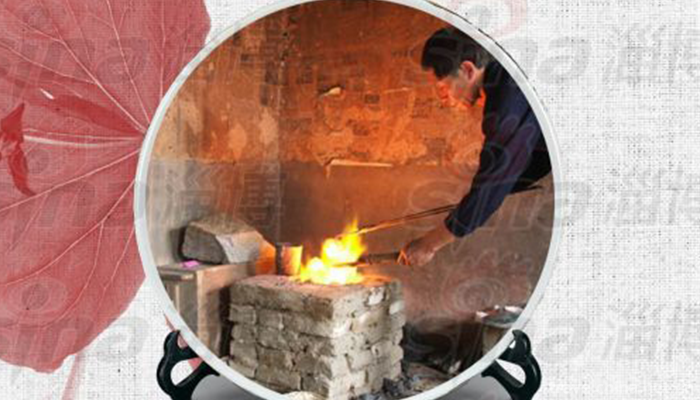Smelting Technology of Gold Chute Stone fill Stove
Smelting Technology of Gold Chute Stone-fill Stove
The smelting technique of gold chute rockfill stove was first seen in the history of Song Dynasty. Since the fourth year of Jingde in the Song Dynasty, Minister Pan Mei-lai adopted this method to supervise Linglong Gold Mine, the first official gold mine in China, this technique has been written into the History of Song Dynasty. After many dynasties, the inheritance has been flourishing, and its principle is still applied today. To this day, Zhaoyuan's goldsmiths who master this skill can trace their genealogy back to seven generations. The smelting technology of gold chute rockfill stove consists of four processes: crushing, grinding, drawing and smelting. Crushing: commonly known as sand breaking, ore should be crushed to the same size as peanuts. Grinding: Crushed ore should be milled after mixing with clean water evenly. The finer the sand grinding, the better, because it determines the level of ore dressing rate in the future.
In 2008, it was selected as the second batch of national intangible cultural heritage list.
Technical history
According to the burning remnants found in ancient pits in Zhaoyuan and the remains of gold mining by the ancestors such as charcoal, iron chisel, hammer, clay bowl and black pottery bowl, the original burnt-fired blasting method was used to extract gold in Zhaoyuan during the Spring and Autumn Period and the Warring States Period. The record of the smelting technique of the gold chute stone stove was first seen in the history of Song Dynasty, and Zhu Biao's Pingzhou Ketan Volume 2 of Song Dynasty recorded: "The metallurgy of the two states, taking sand along the stream and scouring it with wooden trays, is very little and laborious. Denglai gold pit households only use big wood, sawing it, leaving blade marks, throwing sand on it, flooding with water, sand, gold saw grain, very easy to get. This traditional technique of mining gold by hand-operated crushing, grinding, drawing and smelting with hammer, mortar, stone mill, stone mill, chute, Taozun (or crucible) and other advanced tools was later called "chute stove smelting method" by gold historians. In fact, it is the method of extracting gold by gravity beneficiation and high temperature smelting.
Craft procedure
Since the fourth year of Jingde in the Song Dynasty, Minister Pan Mei-lai adopted this method to supervise Linglong Gold Mine, the first official gold mine in China, this technique has been written into the History of Song Dynasty. . To this day, Zhaoyuan's goldsmiths who master this skill can trace their genealogy back to seven generations. The smelting technology of gold chute rockfill stove consists of four processes: crushing, grinding, drawing and smelting. Crushing: commonly known as sand breaking, the ore should be crushed to the same size as peanut rice. Grinding: Crushed ore should be milled after mixing with clean water evenly. The finer the sand grinding, the better, because it determines the level of ore dressing rate in the future. When pushing and grinding, people often sing while pushing in order to forget their hard work and reach the same pace. The simple song is not only full of gold miners'yearning for a better life, but also inherits the local folk culture. Beneficiation: commonly known as "pull flow". The concentrate, which is called gold mud, is selected mainly by gravity principle. This process has relatively high technical content and is relatively complex, and it is the key link of the whole process. When drawing, the ground ore powder is placed above the trough plate and evenly spread out to draw a ditch. When the water in the cylinder above the chute plate enters, the water flow should be controlled by gentle stroke or tapping with a uniform chop from left to right. This is the key to pulling flow, because the flow is large, it is easy to wash away the gold-bearing particles; the flow is small, but it can not wash away the slag, which can not meet the requirements of mineral processing. With the clear water flowing away, the stone slag leaves behind gold-bearing mineral particles, commonly known as "gold mud". After the pull-out, the gold mud is filled in a mud bowl, then dried with fire, and then the rabbit legs which can not adhere to the gold particles are used to clean the gold mud onto the paper, wrapped in paper bags and stored for refining. Smelting: commonly known as "chemical fire". When igniting, paper bags containing gold mud are put into crucibles which are determined to be free of cracks for smelting. After the gold mud is melted, the foam formed by impurities is continuously evaporated or extracted with iron pincers, and then the gold is purified by adding mirabilite and borax. When the molten gold is purified to a certain extent, it is poured into the gold mould, and the gold smelting is completed. The whole process is mastered by the experience and feeling of the goldsmith. The smelting technology of gold chute rockfill stove is not only inseparable from Zhaoyuan's gold mining history, but also occupies an important position in China's gold production history. It is this handicraft handicraft handicraft handicraft handed down from generation to generation that has laid a solid foundation for modern gold mining technology and promoted the development of gold industry.


-
1.China of chunqiu yancheng tourist area
China Spring and Autumn Yancheng Tourist Area (also known as Yancheng, Spring and Autumn Yancheng) is located in the central city of Wujin District, Changzhou City
Time 2018-12-06 -
2.Yellow River Estuary Ecotourism Area
The Yellow River Estuary Ecotourism Area is located in the Yellow River estuary area of Dongying City, Shandong Province. It has unique ecotourism resources of the Yellow River Delta
Time 2019-01-18 -
3.Jinan Baili Yellow River Scenic Area
Jinan Baili Yellow River Scenic Area is adjacent to the northern part of Jinan City. The south gate of the Scenic Area is directly connected to Jinan City's central axis - Jilu Road
Time 2019-01-20 -
4.Yanzhi Mountain Forest Park
Yanzhi Mountain Forest Park is located 45 kilometers southeast of Shandan County. The Gejunma Grassland is opposite to Qilian Mountain
Time 2019-02-28 -
5.Zigong Dinosaur Museum
Zigong Dinosaur Museum is located in the northeast of Zigong City, Sichuan Province, 11 kilometers from the city center. It is a large site museum built on the world famous "Dashanpu Dinosaur Fos
Time 2019-03-22 -
6.Bouyei Pange
Bouyei Pange is a traditional folk song of the Bouyei nationality. It is a folk literary work created and sung in the original Bouyei language. Bouyei Pange is popular in Buyi villages
Time 2019-04-04 -
7.Production Techniques of Silk in Chengdu
Silk is the most distinctive traditional gold and silver handicraft of the Han nationality in Chengdu. This metal craft has a history of more than 1700 years. It has reached a very high artistic level
Time 2019-04-18 -
8.Traditional Cotton Textile Techniques
Chinese traditional textile technology has a long history. Since cotton was introduced from India in the 7th century, Chinese textile industry has changed from linen to cotton.
Time 2019-04-19 -
9.High cavity
Gaoqiang is one of the four major tunes in Chinese opera. Gaoqiang was originally called "Yiyang Cavity" or "Yiqiang Cavity", because it originated in Yiyang, Jiangxi Province.
Time 2019-04-30 -
10.Ma Street book fair
The Majie Book Club is a grand Chinese folk music festival. Located 5 kilometers south of Baofeng County, Henan Province, it is a "pilgrimage site" for rap artists all over the country. Ever
Time 2019-05-15 -
11.Zerou
Zerou (Shangyu Zerou), also known as Ashze, is a Tibetan folk dance in Guide County, Qinghai Province. Especially "Shangyu (Chinese: lower row) is soft" is the most important. They often per
Time 2019-07-16 -
12.Neijiang tertiary industry
In 2019, the investment in real estate development in Neijiang City will increase by 2.7% over the previous year. The construction area of commercial housing was 12.4341 million square meters, an increase of 8.9%. The sales area of commercial housing was 4.6939 million square meters, an increase of 8.0%.
Time 2020-12-16